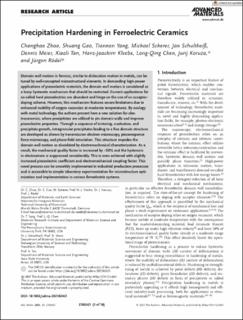| dc.description.abstract | Domain wall motion in ferroics, similar to dislocation motion in metals, can be tuned by well-concepted microstructural elements. In demanding high-power applications of piezoelectric materials, the domain wall motion is considered as a lossy hysteretic mechanism that should be restricted. Current applications for so-called hard piezoelectrics are abundant and hinge on the use of an acceptor-doping scheme. However, this mechanism features severe limitations due to enhanced mobility of oxygen vacancies at moderate temperatures. By analogy with metal technology, the authors present here a new solution for electroceramics, where precipitates are utilized to pin domain walls and improve piezoelectric properties. Through a sequence of sintering, nucleation, and precipitate growth, intragranular precipitates leading to a fine domain structure are developed as shown by transmission electron microscopy, piezoresponse force microscopy, and phase-field simulation. This structure impedes the domain wall motion as elucidated by electromechanical characterization. As a result, the mechanical quality factor is increased by ≈50% and the hysteresis in electrostrain is suppressed considerably. This is even achieved with slightly increased piezoelectric coefficient and electromechanical coupling factor. This novel process can be smoothly implemented in industrial production processes and is accessible to simple laboratory experimentation for microstructure optimization and implementation in various ferroelectric systems. | en_US |

